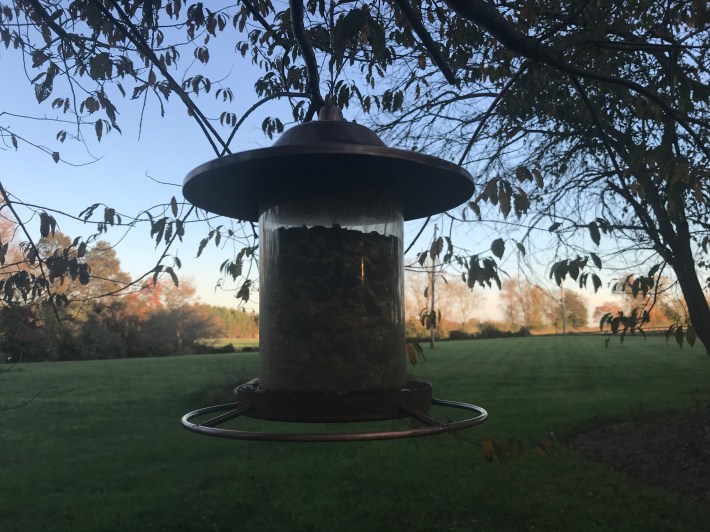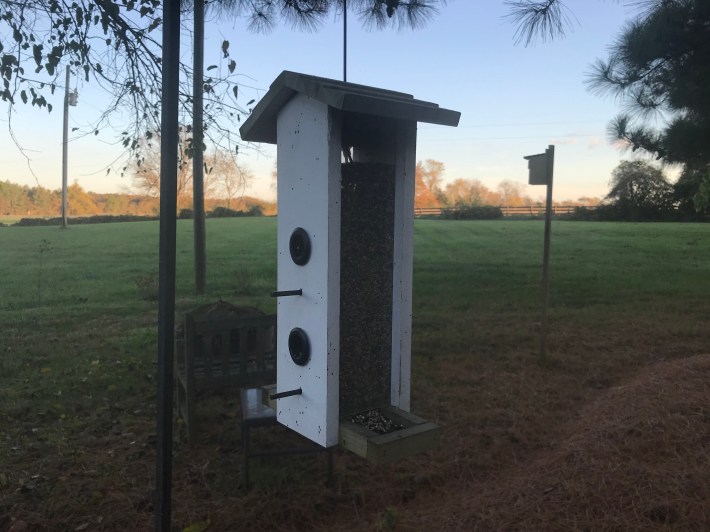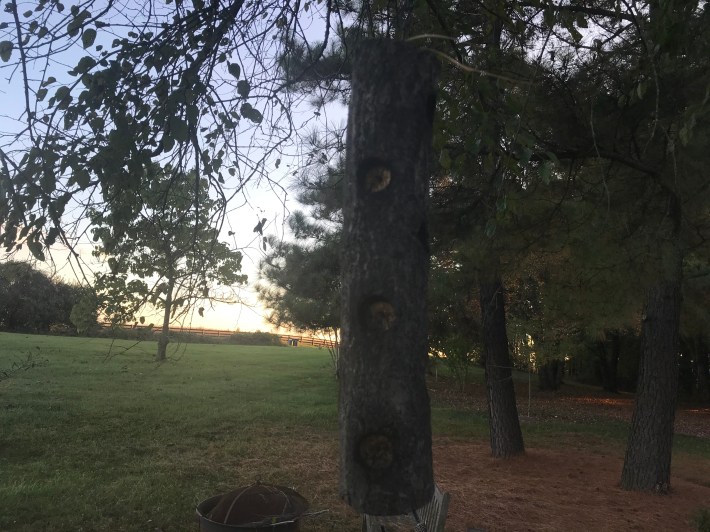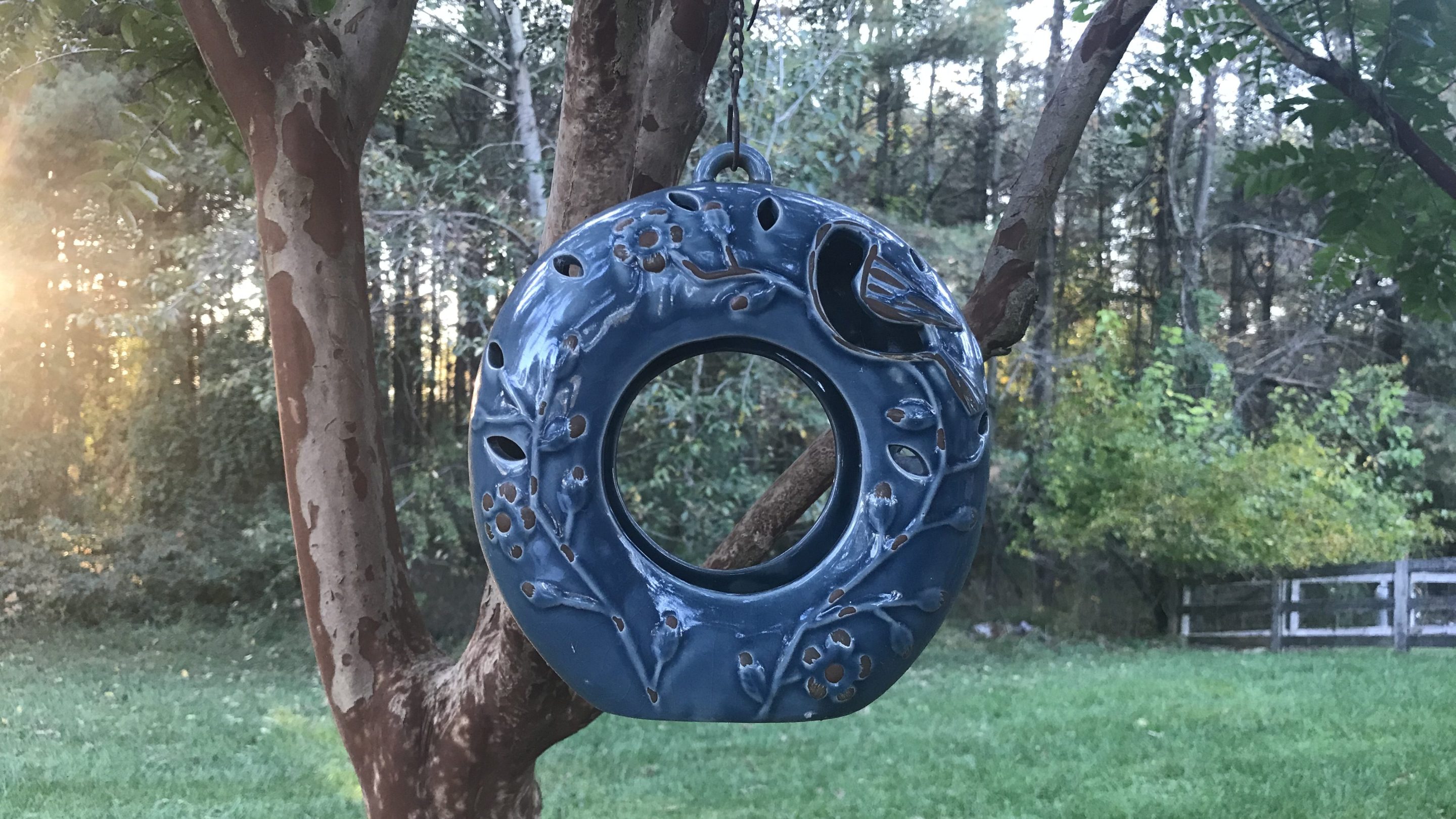Autumn is well upon us, my friends. The sun is in the south. Bitter chill is beginning to spread from the darkening Arctic north, and the cold is driving before it all sorts of migratory birds, headed for their winter homes. And you know what that means, pals: Now is the time to put out food for the birds. Feed the birds!
Some of the birds that will eat food from your bird feeder will be exciting migratory types that only show up for a couple weeks out of the whole year. Just last week I saw something called a Swainson's Thrush in a patch of woods up the road from my home. These handsome guys winter in Bolivia and Panama and places like that. They're rare in my neck of the woods, and are virtually never seen after October, but autumn is a great time to spot them on their run south. No, the Swainson's Thrush did not visit my bird feeders. They are not those sorts of birds! But the point stands. Right now, as you sit there at your desk, interesting birds are making the trek from cold places to warm places, and they are stopping for rest here and there, and some worthwhile number of them will drop in for a snack if you've got some delicious bird food where they can get to it.
And then there are the cool birds that winter in exactly your area of the world. Around where I live we've got House Finches, Goldfinches, intrepid little Carolina Wrens, Carolina Chickadees, Black-Capped Chickadees, Tufted Titmice, and adorable White-Breasted Nuthatches, and all of them are here pretty much year-round. And then we get a big winter crowd of Dark-Eyed Juncos, little round guys who bop around on the ground under the feeders. And also Blue Jays and Northern Cardinals and Mourning Doves. And various woodpeckers! I am starting to have anxiety about leaving out any of the good birds! Lots of really good birds spend the whole winter within a few hundred feet of your home, is what I'm getting at. If you put out a little food each morning, they will make whatever arrangements birds make in order to be around your feeders during the cold days of winter.
Several of these birds will be transitioning from summer diets to winter diets. House Finches like to eat berries in the summer, but in the winter they are big-time hogs at the feeders. Eastern Bluebirds will be a lot more interested in supplementing their diets with dried mealworms in the winter than in the summer. Mourning Doves eat seed all year round, but in the cold of winter they will spend an entire day just dozing under a feeder, waiting for the rowdy songbirds overhead to splash seed down below. A bag of black sunflower seeds will satisfy a huge variety of hungry birds riding out the lean times in the various crannies of your neighborhood.
I have lots of feeders, because I am a bird psycho. If you do not have a good sturdy feeder that you trust to handle your bird-feeding needs, consider the following options:

This is my best feeder, and I have had it for probably seven years. It's a clear plastic cylinder with a hanger made of metal cord, and a top that slides up and down the cord to allow for cleaning and filling with food. It holds a lot of food, it's sturdy, and birds dig it. Like all good feeders, it hangs by a loop and not a hook; when some asshole squirrel grabs onto it and starts swinging it around like a real jerk, it will not come unhooked and fall to the ground, because there is no hook. There's almost nothing to scratch or dig or pull on, so it has not been torn up or broken, except for the time that I took it down to refill it and then forgot about it and then drove over it with my lawnmower. Even then, it was not destroyed!

This attractive feeder looks great hanging from a hook in your yard. Buyer beware! Cheap wood feeders can pretty easily be ripped to shit by marauding flocks of European Starlings, or crows, or other unwanted visitors. Those little pegs for perching will not hold up if some fatso squirrel decides to use one as a pull-up bar. This type of feeder is built for tiny seeds and tiny birds, and tiny birds will indeed like it, so long as you can keep it upright. But even relatively large doofus birds, like the Red-Bellied Woodpecker, will start to rattle this thing apart when they hang onto the bottom ledge for a few clumsy bites. And those are good birds! Some of the best, in one man's opinion.

I could've taken a clearer picture of this one, but you get the idea! It's a hunk of wood that I made into a feeder by drilling holes into it with a nice fat spade bit, then hanging it with a length of chain. You fill this guy up by spackling those holes with suet, which you can buy from one of the big home goods stores or you can make yourself. Nuthatches love this guy because they are huge weirdos who prefer to be upside-down when they eat. Squirrels will give it a go but the log feeder spins and tilts and otherwise gives them hell, which can be very entertaining. But the birds who will most love the log feeder are woodpeckers, who are pure magic. They will clutch the sides of this thing and smash their faces into the holes with tremendous gusto, and you will be delighted.
The feeder up at the top of this blog is blue ceramic and has no parts, which means it is sturdy and won't be scratched or shredded or busted up by moron squirrels or heavy Blue Jays. Last winter, in fact, I used the blue feeder as a squirrel feeder, and stocked it with peanuts and dried corn, and it was fine. A fine feeder. I also have a hanging tray feeder and another wood-sided, house-shaped feeder, plus another plastic feeder more or less exactly like the sturdy cylinder one. And a second log feeder. And six suet cages. Listen! It's very easy to get carried away with feeding the birds. Don't go crazy with this—just get one single feeder, hang it from a thumb-thick branch or from a hook you drill into a mighty tree limb, put some seed in it, and enjoy what happens.
Do not think because you live in a small home or an urban neighborhood that you should not bother trying to feed the birds. You don't need trees and fields and so forth. All you need is an overhang of some sort, into which you can screw a cheap metal hook, and a feeder, and some seed. The birds will do the rest. And now is the time. Every minute you spend watching the birds will be a minute where you are completely unplugged from the ghastly hell-world around you. Soon it will be dark and cold and somehow even shittier than it already is. This will all be so much more bearable if you have boisterous gangs of poofy little songbirds jostling for a midday snack at your very own bird-feeding station.






